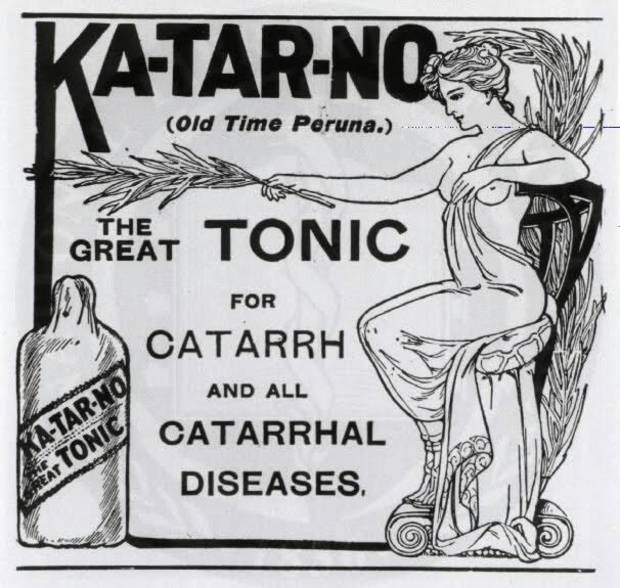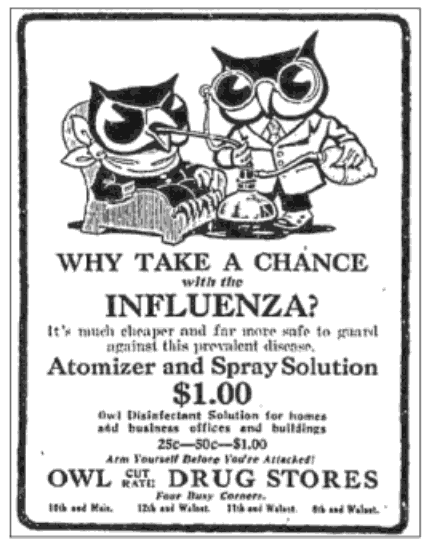感染症と心理
1918年のスペインインフルエンザでも、様々な、いんちき療法が流行した。ウィスキーが効くとされて、価格が高騰したりした。
その他、有名だったのが、Vick's Vapor Rubなど。そして、タマネギを食べるというのもあった、
オイルやらクリームやら、何でもあり。
そんな20世紀初頭のスペインインフルエンザから100年が経過した。状況がよくなっているかというと、なんとも。
1918年のスペインインフルエンザでも、様々な、いんちき療法が流行した。ウィスキーが効くとされて、価格が高騰したりした。
With whiskey hailed as a cure, its price skyrocketed. The flu outbreak caused a run on whiskey, which jumped to $18 a quart in Oklahoma City, according to an Oct. 15, 1918, article in The Daily Oklahoman. Newspaper ads from that period hawked quack cures, everything from whiskey to mouth gargle; Vicks reported a shortage of VapoRub and those in rural areas turned to home remedies, like rock candy in whiskey and cloverleaf salve. Of course, there is no cure for the flu.
治療法として喜ばれたウィスキーの価格は急騰した。1918年10月15日のThe Daily Oklahomanの記事によると、インフルエンザの発生により、ウイスキーが流行し、オクラホマシティで1クォートあたり18ドルに跳ね上がった。当時の新聞は、ウィスキーから口内洗浄まで、あらゆるいんちき療法を広告を載せた。VicksはVapoRubの品不足を報告し、村部の人々はウィスキーやクローバーリーフのロックキャンディなどの家庭薬に目を向けた。もちろん、それらのインフルエンザ治療効果はない。

[Juliana Keeping: "6 surprising facts about the 1918 flu pandemic" (2016/02/12) ]
その他、有名だったのが、Vick's Vapor Rubなど。そして、タマネギを食べるというのもあった、
Cures for the Flu
During the pandemic a plethora of cures emerged. One advertisement in the paper, called "Pape's Cold Compound" boasted it could end colds and grippe quickly. Another home remedy was eating onions. A farmer J.W. Gardocky saw an opportunity to promote onions curative properties and emphasize a sense of patriotic duty to drive the flu away. His advertisement read, "An onion car arrived today, Labelled red, white, and blue, Eat onions, plenty, every day, And keep away the Flu." Home remedies and folk medicine was extremely popular as people were desperate to find something that alleviated the symptoms of the flu. It was extremely difficult to tell if any of the remedies had a direct effect on the virus other than a placebo effect. Something else that caught people's attention to help with the influenza was Vick's Vapor Rub. It was extremely popular and constantly sold out at local drugstores. The Red Cross suggested people should use the rub at the first sign of a cold. To treat a head cold it was necessary to melt the Vick's Vapor Rub on a spoon and inhale the concoction. One could also use a benzoin steam kettle. The first step was to fill it with water, bring to a boil, then add 1/2 teaspoon of Vapor Rub to the kettle.
パンデミックの期間、多くの治療法が出現した。"Pape's Cold Compound"と呼ばれる製品の新聞広告は、風邪やインフルエンザをすぐに終わらせると自慢した。この他の家庭療法がタマネギを食べることだった。農家のJ.W. Gardockyは、タマネギの治癒効果を宣伝し、インフルエンザを追い払う愛国的な義務感を強調する機会を見出した。彼の広告には「タマネギの車が今日到着。赤、白、青のラベルが付き。毎日タマネギをたっぷり食べて、インフルエンザを予防しよう」と書かれていた。人々はインフルエンザの症状を緩和するものを見つけることに必死であったため、家庭薬と民間療法は非常に人気があった。どの治療法がプラセボ効果以上のウイルスに対する直接的な効果を持っているか判断することは非常に困難だった。インフルエンザを治療法で、人々の注意を引いたのがickのVapor Rubだった。Vapor Rubは非常に人気があり、ドラッグストアでは常に売り切れだった。赤十字社は、風邪の最初の兆候でRubの使用を示唆した。鼻風邪治療にはVick's Vapor Rubをスプーンで溶かし、調合物を吸い込む必要があった。ベンゾイン蒸気ケトルも使用された。最初のステップは、それを水で満たし、沸騰させてから、小さじ1/2のVapor Rubをケトルに加えることでした。

[ "INFLUENZA 1918-1919" ]
オイルやらクリームやら、何でもあり。
そして、14世紀のペストのときと同じ「悪臭」にも、人々は眼を向けた。
The pandemic gave rise to scores of "miracle drugs." Newspapers car-ried ads for marvels: "Influ-BALM Prevents Spanish Flu," "Benetol, a powerful bulwark for the preven-tion and treatment of Spanish influ-enza." Another ad asked: "Sick with influenza? Use Ely's cream Balm. No more snuffling. No struggling for breath." A similar ad praised a competing drug: "Use Oil of Hyomi. Bathe your breathing organs with antiseptic balsam." Munyon's Paw Paw Pills guaranteed "influenza insurance." C. I. Hood & Company of Lowell, Massachusetts, offered three anti-influenza potions: Hood's Sarsaparilla, which, its ad boasted, was ideal for "impure, exhausted blood"; Hood's Pills, which would "regulate the bowels to a nicety"; and Hood's Pepitron (chocolate pills), which would fortify the entire body. Ads for Tanlac Reconstructive Tonic told the truth in one respect: "Influenza Claims More Victims Than German Bullets."
パンデミックにより、多くの「奇跡の薬」が出現した。新聞は驚異の広告を掲載しました:「Influ-BALMはスペイン風邪を予防する」「Benetolはスペイン風邪の予防と治療の強力な防波堤」。別の広告はこうだった。「インフルエンザにかかっていますか?Elyのクリームバームを使おう。鼻水は止まり、息苦しさもなくなります。」同様の広告が競合薬を称賛した。「Hiyomiのオイルを使おう。防腐剤Balsamで呼吸器官を濡らそう。」MunyonのPaw Paw Pillsは「インフルエンザ保険」を保障した。マサチューセッツ州LowellのC. I. Hood & Companyは、3つの抗インフルエンザ薬を販売した。HoodのSarsaparillaは「不順で息切れた血液」に理想的で、Hoodの錠剤は「腸のきれい」にし、HoodのPepitron(チョコレート錠剤)は体全体を強化する。Tanlac Reconstructive Tonicの広告は、「インフルエンザはドイツの弾丸よりも多くの犠牲者を出す」という点で真実を語っている。
Desperate people also turned to folk medicine, traditional remedies favored over generations within various societies. Often they put their faith in magical objects. Southern mountain folk, for example, kept shotguns under sickbeds to "draw out" the fever. Elsewhere, to ward off infection, people hung cloth bags filled with camphor around their necks, or they swallowed doses of red pepper, powdered asparagus, or "kerosene on sugar." Recipes called for wearing a necklace of chicken feathers or asafetida, also known as "devil's dung" an herb that "smelled like rotten flesh." The idea was that foul odors could chase influenza "germs" away. During outbreaks of the Black Death, Europeans had in-haled the stench from latrines for the same reason. Some Americans swore by the curative powers of onions. An Oregon woman boasted that she doused her sick four-year-old daughter with onion syrup and buried her from head to toe for three days in freshly cut, eye-watering onions. She said the child recovered—to the delight of onion growers. [29]
絶望的な人々は民間療法にも目を向けた。伝統的な治療法はさまざまな社会の中で世代を超えて好まれた。多くの場合、人々は魔法の事物を信頼した。たとえば、南部の山岳地域の人々は、熱を「引き出す」ために病床の下に散弾銃を置いていた。他の場所では、感染を防ぐために、人々はショウノウを入れた布袋を首にかけたり、赤唐辛子や粉末アスパラガス(糖分ケロシン)を飲み込んだ。レシピでは、「腐った肉のように臭い」のする「悪魔の糞」としても知られているm鶏の羽やアサフェティダのネックレスを身に着けることが求めていた。悪臭はインフルエンザの「細菌」を追い払うことができるという考えだった。ペスト発生の時代に間、ヨーロッパ人は同じ理由でトイレから悪臭を吸い込んだ。一部のアメリカ人はタマネギの治癒力を信じた。オレゴン州の女性は、病気の4歳の娘にタマネギシロップを与え、新鮮な切立ての玉ねぎに3日間、頭からつま先まで漬けたと自慢した。彼女はタマネギパワーで子供が回復したと言った。
[ Albert Marin: "Very, Very, Very Dreadful: The Influenza Pandemic of 1918", Random House Children's Books, Jan 9, 2018, pp.98 - 99 ]
そんな20世紀初頭のスペインインフルエンザから100年が経過した。状況がよくなっているかというと、なんとも。


コメントをかく